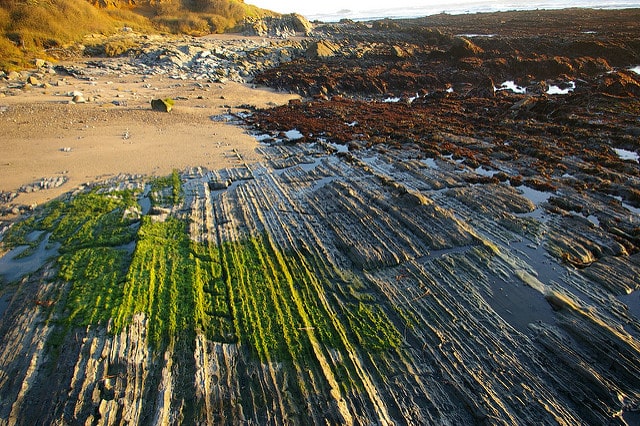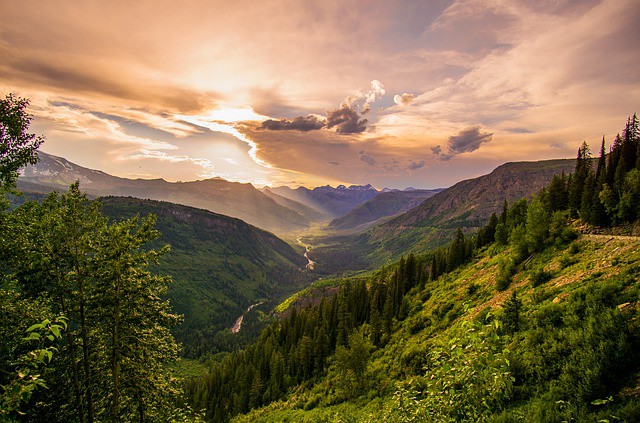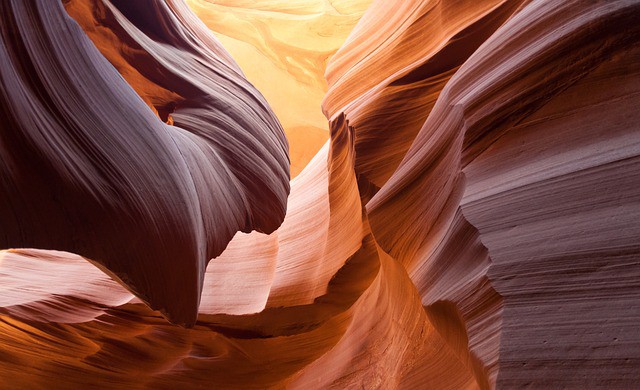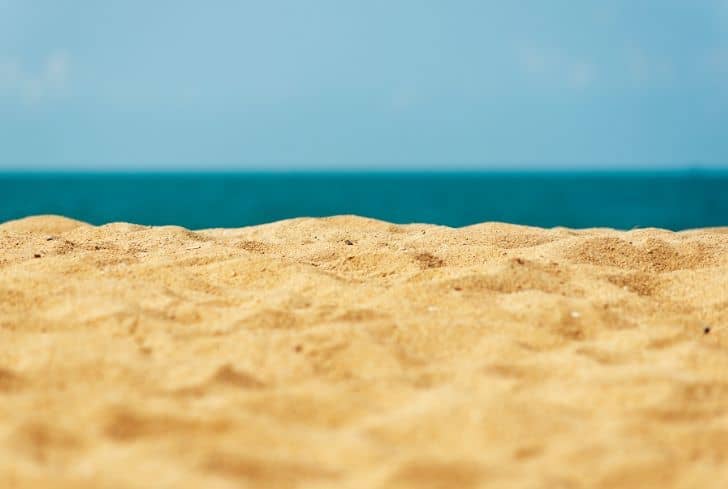Sedimentary Rocks: Formation, Types and Examples

Sedimentary rocks are the most common rock types which are freely exposed on the earth’s surface. They are formed from other rock materials since they are made up of the buildup of weathered and eroded pre-existing rocks.
The weathering, erosion and the eventual compaction of igneous, metamorphic or formerly structured sedimentary rocks among other biological sedimentations lead to the formation of sedimentary rocks.
So, sedimentary rocks are produced from previous rocks that are relentlessly weathered or eroded and then deposited where they undergo compaction and cementation through a process known as lithification- changing of sediments into a rock. This is how the name sedimentary rock was coined.
As per Wikipedia,
“Sedimentary rocks are types of rock that are formed by the deposition and subsequent cementation of that material at the Earth’s surface and within bodies of water. Sedimentation is the collective name for processes that cause mineral and/or organic particles (detritus) to settle in place. The particles that form a sedimentary rock by accumulating are called sediment.
Before being deposited, the sediment was formed by weathering and erosion from the source area, and then transported to the place of deposition by water, wind, ice, mass movement or glaciers, which are called agents of denudation.“
Formation of Sedimentary Rocks
All rocks, be it igneous, metamorphic, or the already existing sedimentary rocks are constantly subjected to weathering and erosion. Tiny debris from the rock masses and mountains are eroded together with soils, sand, and other granite pieces that are normally washed from highlands to low areas.
After many years, these materials finally settle down through the process of sedimentation. Some may accumulate underwater and others on the lower areas of the land.
The weathering and erosion is normally due to the forces of water, thermal expansion, gravity, wind, and salt crystal expansion that breaks down the pre-existing rocks into small pieces and then carried away to some distance low areas. As the materials move, they are smoothened and rounded by abrasion, and they settle down by leaving pore spaces between the grains which make them achieve their distorted shape.
At this point, they have deposited a layer after layer to form a new sheet of homogenous material. From here, the compaction and cementing agents such as oxides, carbonates, and silica combine together with the deposited material.
The compaction effect due to the weight of the piling layers of materials reduces the porosity of the rocks formed and intensifies the cohesion between the grains. At times, fossil fuels and organic matter may settle within the sediments leading to cementation.
Cementation is the gluing of the rock pieces together either by salt compounds or organic matter. When these materials eventually harden, the mixture is transformed into a rock.
Thus, sedimentary rocks are formed from sediment deposits through the process of weathering, erosion, deposition and finally compaction and cementation. Examples of sedimentary rocks include mudstone, limestone, sandstone, and conglomerate.
Types of Sedimentary Rocks
Sedimentary rocks are of three basic types. These include clastic, chemical, and organic sedimentary rocks.
1. Clastic Sedimentary Rocks
Clastic sedimentary rocks are formed from the buildup of clatics: small pieces of fragmented rocks deposited as a result of mechanical weathering then lithified by compaction and cementation. Examples of Clastic sedimentary rocks include sandstone, shale, siltstone, and breccias.
2. Chemical Sedimentary Rocks
Chemical sedimentary rocks are formed when the water components evaporate, leaving dissolved minerals behind. Sedimentary rocks of these kinds are very common in arid lands such as the deposits of salts and gypsum. Examples include rock salt, dolomites, flint, iron ore, chert, and some limestone.
3. Organic Sedimentary Rocks
Organic sedimentary rocks are formed from the accumulation of any animal or plant debris such as shells and bones.
These plant and animal debris have calcium minerals in them that pile on the seafloor over time to form organic sedimentary rocks. Examples include rocks such as coal, some limestone, and some dolomites.
Examples of Sedimentary Rocks
There are several types of sedimentary rocks. Here are the detailed examples of the various sedimentary rocks.
1. Breccia
Breccia are clastic sedimentary rocks made up of angular rock broken parts that are cemented together. The angular shape means that the broken parts haven’t traveled far from their pre-existing materials. The broken pieces are similar to conglomerate because of their large pea-sizes. Breccias are commonly found along fault zones and they take any color.
2. Conglomerate
Conglomerates are clastic sedimentary rocks composed of semi-rounded rock fragments cemented together. The rounded fragments depict that they have undergone abrasion and traveled a significant distance from their pre-existing materials.
Conglomerates fragments are commonly deposited along the shoreline or stream channel and they are pea-sized or larger. They are also sometimes referred to as pudding stone.
3. Siltstone
Siltstones are composed of small-sized rock particles that are finer than sand grains but coarser than clay. It is among the clastic sedimentary rocks which are the most difficult to identify since it appears almost similar to fine-grained sandstone or a coarse shale. They normally occur in a wide variety of colors.
4. Sandstone
Sandstones are clastic sedimentary rocks made up of cemented sand grains. Sandstones vary from fine-grained to coarse-grained are readily distinguishable by the naked eyes.
Mature sandstones or quartz sandstones are light-colored and majorly consist of rounded and well-sorted quartz grains. Graywackes or immature sandstones consist of angular grains of diverse minerals. Sandstones are generally white, red, gray, pink, black, or brown in color.
5. Shale
Shale consists of clay minerals or clay-sized pieces that have been compacted by the weight of the overlying rock materials. Shale belongs to clastic sedimentary rocks and they tend to split into fairly flat pieces.
Shales are of many colors including gray, red, brown, or black depending on their composition of iron oxides and organic materials. They are generally a good source of fossils and are mostly found at the bottom of lakes or oceans.
6. Dolomite
Dolomites are chemical sedimentary rocks that almost resemble calcite. The similarity is because dolomite at first begins to take shape as limestone but they are later chemically altered through the substitution of some of its calcium by magnesium.
7. Chert
Cherts are chemical sedimentary rocks formed due to the deposition of cryptocrystalline quartz. Cherts are of dull brown or gray in color and are often found as nodules firmly enclosed in limestone which protrude out of the limestone when the limestone is slowly immersed in water.
Jasper is red, bright yellowish-brown or reddish-brown chert. Flint on the other hand is chert with a waxy luster.
8. Limestone
Limestones are chemical sedimentary rocks made up of the mineral calcite. They may be hard to visually identify. Their colors vary from brown, dark gray, to light gray.
The common types of limestone include fossiliferous limestone rich in fossils, lithographic limestone that is very fine-grained, coquina limestone composed of broken shell fragments, encrinal limestone composed of crinoid fragments, and travertine deposited by the forces of moving surface water.
9. Rock Salt
Rock salt is chemical sedimentary rocks often made up of the mineral sodium chloride. Salt is colorless or white and might be colored when mixed with impurities such as clay or iron oxide. It is easily identified by its salty taste and it is also water-soluble. It also has the mineral name ‘halite.’
10. Gypsum
Gypsum belongs to chemical sedimentary rocks. It is soft and can be easily bruised. It is usually white in color and is used to produce plaster of Paris.
11. Amber
Amber is an organic sedimentary rock and is naturally plastic and is light-weight compared to the majority of the typical stones. Amber is simply a hardened tree sap and its colors ranges from transparent yellow to creamy yellow or red to dark brown.
12. Coal
Coal belongs to organic sedimentary rocks are made up of the buildup of decomposed plant material in a swampy environment. Coal is combustible in nature and is frequently extracted for use as fuel. It ranges from brown to black in color and its concentration depends on the compaction and alterations of the pre-existing organic materials. Examples of coal in order of the degree of compaction and alteration include peat, lignite, bituminous, and anthracite.






